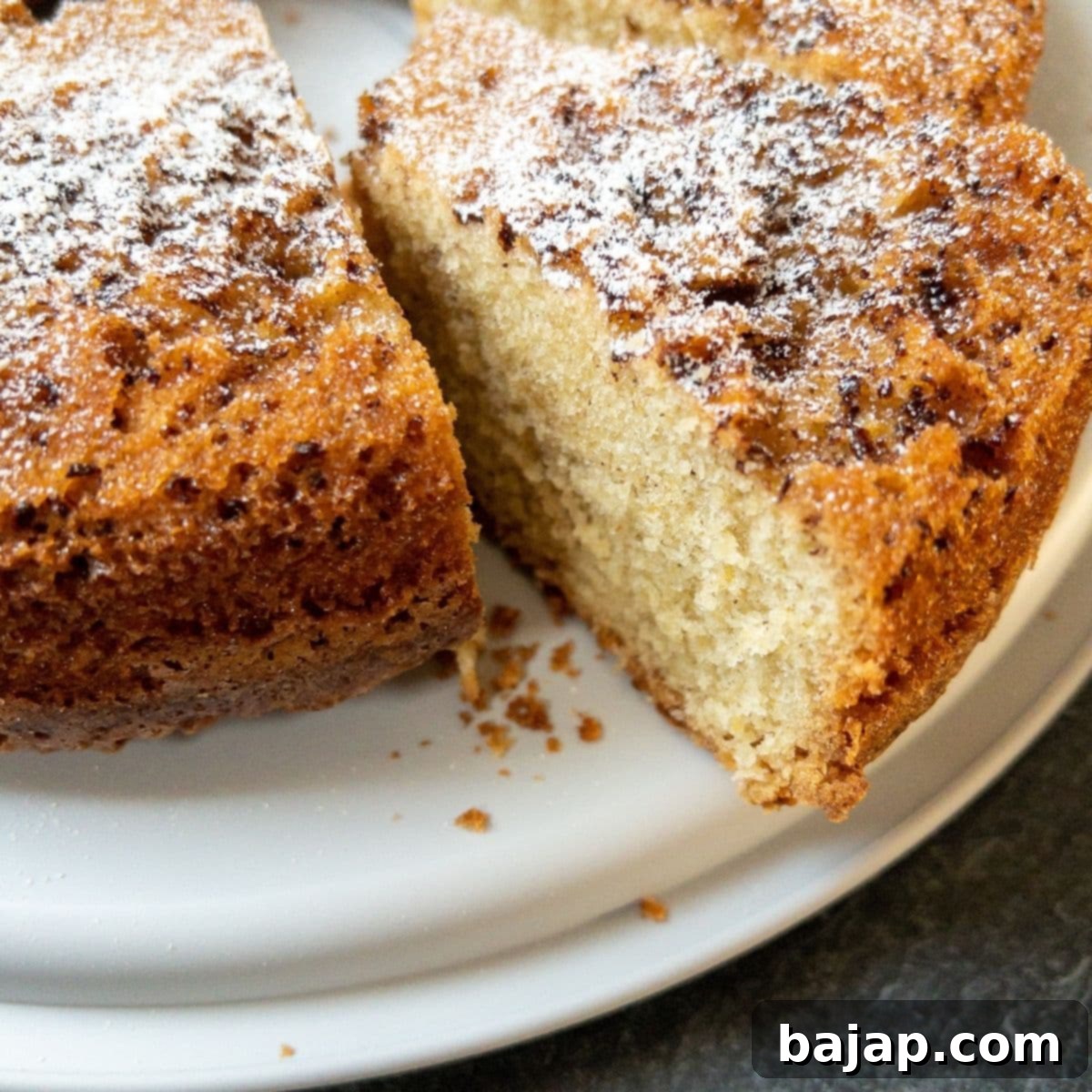The Ultimate Fluffy & Butter-Free Potato Flour Eggnog Cake Recipe: A Delightful Indulgence
Prepare to be amazed by a cake of the most delicate and exquisite kind! This extraordinary creation combines the unique lightness of potato flour with the familiar structure of wheat flour, all elevated by a generous infusion of rich eggnog. For the best flavor experience, we highly recommend using your homemade eggnog, which adds an unparalleled depth of flavor. One of the many benefits of this recipe is the addition of oil, which eliminates the need for any butter, resulting in an incredibly moist and tender crumb that simply melts in your mouth. This isn’t just a cake; it’s a testament to simple, delicious baking!
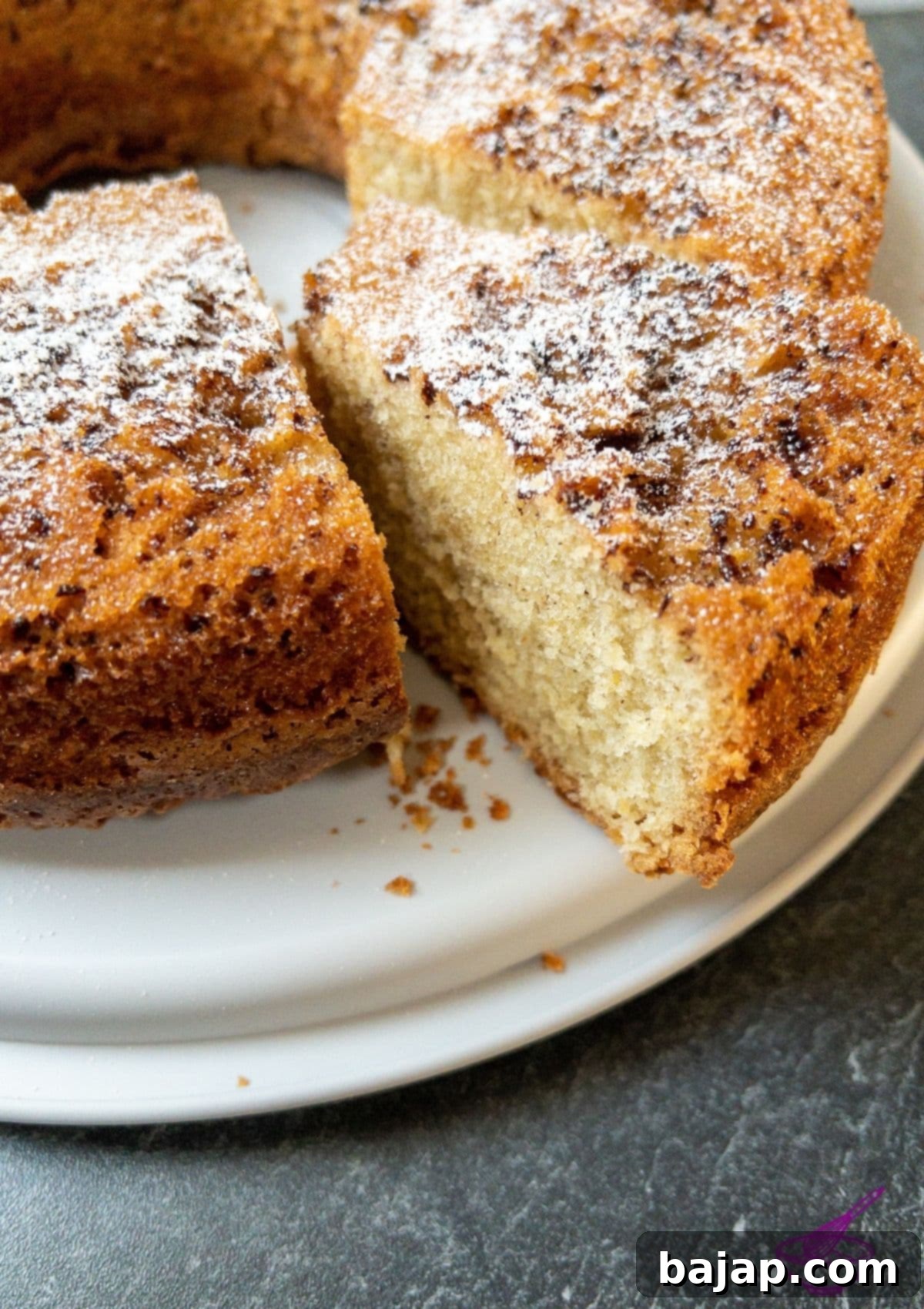
This
If you find yourself utterly captivated by the rich and creamy flavor of
A Baker’s Confession: A Lesson in Batter Consistency
As wonderfully gorgeous and utterly delicious as this potato flour eggnog cake turned out, I must make a confession. While baking, I made a rather stupid mistake. Thankfully, it did not affect the final result in terms of taste or overall texture, but it’s a valuable lesson that I absolutely have to make you aware of, so you can avoid a similar mishap!
I had a small bag of chocolate chips leftover from another project, and in a moment of impulse, I decided they would be a lovely addition to this cake. When the dough was ready, I didn’t pay sufficient attention to its consistency and simply mixed in the chocolate chips. Immediately, I saw them begin to sink. They simply dropped to the very bottom of the mixing bowl, a clear sign of impending disaster.
At that point, it was too late to reverse my actions. The dough for this particular cake possesses such a wonderfully fluid and light consistency that it is absolutely not suitable for incorporating heavy additions like chocolate chips. They are simply too dense, and the delicate batter lacks the structure to suspend them evenly throughout. Since there was nothing I could do to remedy the situation after the fact, I continued with the baking process as usual, hoping for the best.
And indeed, at the end of the baking time, as expected, all the chocolate chips had sunk and formed a layer stuck to the bottom of the cake. While not ideal for an even distribution, it surprisingly wasn’t a problem for the cake itself. It gave it a unique, somewhat marbled pattern at the base, which was an unexpected, albeit unintentional, decorative touch. However, for the perfect, unadulterated fluffy experience of this beautiful eggnog cake, you genuinely don’t need any additional mix-ins like chocolate chips. To ensure you don’t waste your precious chocolate (or create an uneven texture), it’s best to leave them out altogether when making this specific recipe. Stick to the pure, simple deliciousness!
This experience highlights a crucial aspect of baking: understanding your batter. For light, fluid batters like this one, heavy additions will almost always sink. If you absolutely want to add mix-ins to a light batter, a common trick is to lightly dust them with a small amount of flour before folding them in. This thin coating of flour helps them adhere to the batter and prevents them from sinking. However, for this specific potato flour eggnog cake, its beauty truly lies in its unadorned, fluffy texture and rich eggnog flavor, so we recommend embracing its simplicity.
[feast_advanced_jump_to]
🥘 Ingredients for the Perfect Eggnog Cake
Crafting this delightful eggnog cake requires a selection of fresh, high-quality ingredients. Each component plays a vital role in achieving its signature fluffy texture and rich flavor. Here’s what you’ll need:
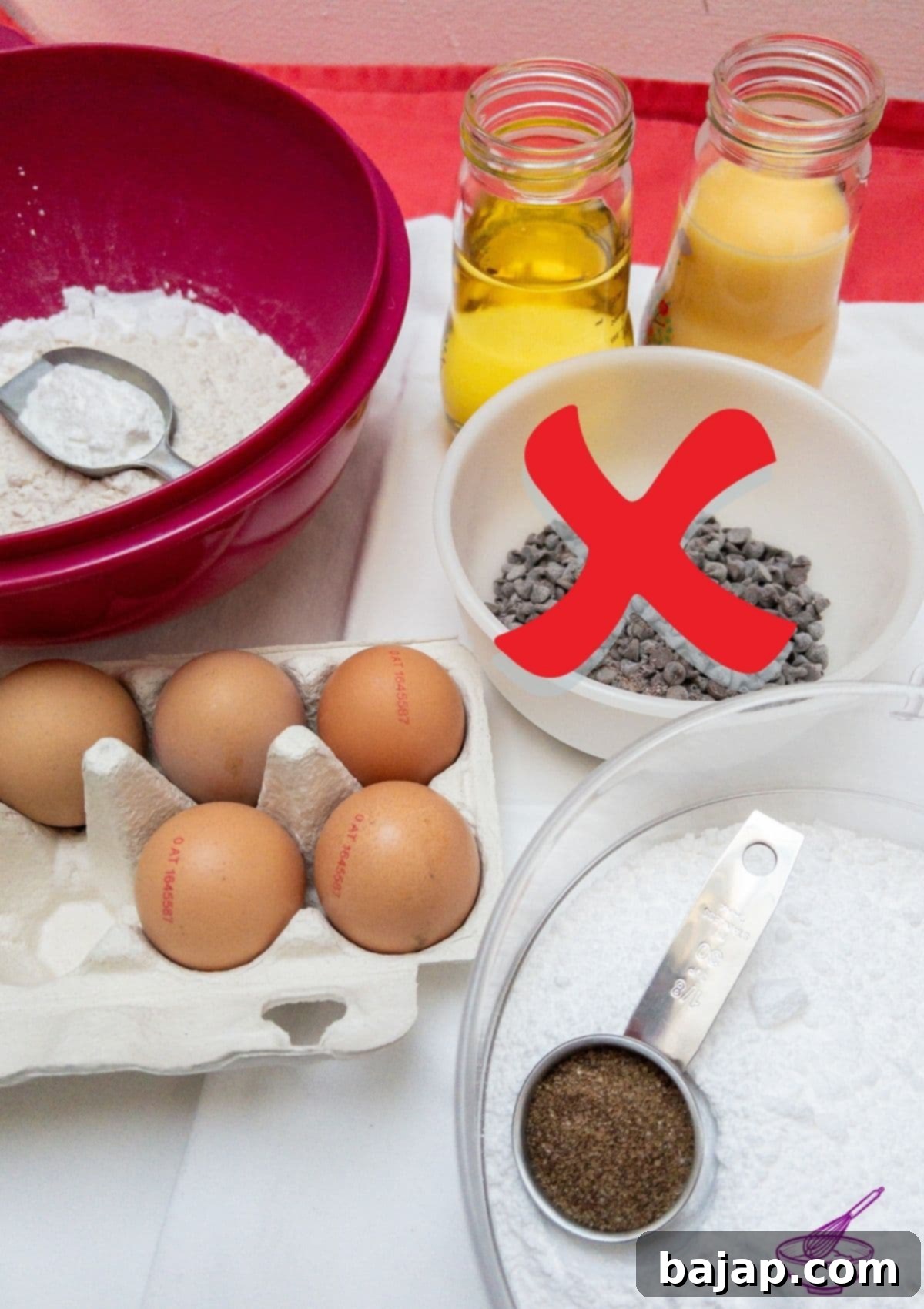
- Eggs: Fresh, large eggs are crucial for structure and richness.
- Powdered sugar: Also known as confectioners’ sugar, it dissolves easily, ensuring a smooth batter and a delicate sweetness.
- Vanilla sugar: Adds a subtle, aromatic vanilla note that complements the eggnog beautifully.
- Oil: Using a neutral-flavored oil (like grapeseed, canola, or a light olive oil) instead of butter contributes to the cake’s incredible moistness and light texture.
- Eggnog: The star ingredient! You can use your homemade eggnog for an extra special touch, or a high-quality store-bought Advocaat or egg liqueur. The quality of your eggnog will significantly impact the final flavor.
- All-purpose flour: Provides the foundational structure for the cake.
- Potato flour: The secret to this cake’s unique tenderness and light crumb. It absorbs moisture well, resulting in a very delicate texture.
- Baking powder: The leavening agent that helps the cake rise and achieve its airy consistency.
- Butter or baking spray: Essential for greasing the pan to prevent sticking and ensure a perfect release.
- Powdered sugar: For a beautiful and simple final dusting before serving.
For precise measurements and quantities, please refer to the detailed recipe card at the end of this article.
🍽 Essential Equipment for Baking Success
Having the right tools at hand makes the baking process smooth and enjoyable. Here’s the essential equipment you’ll need for this potato flour eggnog cake:
- Springform Bundt pan: A Bundt pan gives the cake its distinctive shape, while the springform mechanism makes for easy release.
- Mixing bowl: At least two are helpful – one for dry ingredients and one for wet.
- Food processor // Electric mixer: Either a stand mixer or a powerful hand mixer will be necessary to achieve the desired creamy consistency for your batter.
- Cooling rack: Crucial for allowing the cake to cool properly and prevent sogginess.
- Close-meshed sieve: For sifting powdered sugar and ensuring a lump-free mixture.
- Tablespoon: For measuring smaller quantities.
- Dough scraper (or spatula) for folding in: Gentle folding ensures the batter remains light and airy.
🔪 Step-by-Step Instructions: Baking Your Eggnog Dream Cake
This wonderful cake is a joy to bake, known for its straightforward process where most ingredients come together quickly and easily. It’s one of those recipes that proves delicious results don’t always require complicated steps. So, let’s get right to it and create this simple, yet spectacular, dessert!
- Preheat your oven: Begin by preheating your oven to 160 °C // 320 °F using top/bottom heat. Ensuring your oven is at the correct temperature before the cake goes in is key to even baking.
- Prepare dry ingredients: In a separate mixing bowl, take a moment to mix the two types of flour (all-purpose and potato flour) and the baking powder together thoroughly. This step, known as sifting or whisking dry ingredients, ensures that the leavening agent is evenly distributed, leading to a consistent rise in your cake. Having this mixture prepared in advance means it will be ready to incorporate smoothly later.
- Cream the wet ingredients: Now, grab a larger mixing bowl or attach the mixing bowl to your kitchen machine (stand mixer). Sift the powdered sugar into it through a close-meshed sieve. Sifting helps remove any lumps, making for a smoother batter. Then, add the vanilla sugar and the eggs. Beat these ingredients together until they are wonderfully creamy and pale in color. This process incorporates air, which is vital for the cake’s light texture.
- Combine wet and dry: Continue by gently adding the oil and the luscious eggnog to the creamed mixture. Mix until just combined. Following this, gradually add the flour-baking-powder-mixture that you prepared at the beginning. Mix on a low speed or fold gently with a spatula until no streaks of dry flour remain. Be careful not to overmix, as this can develop the gluten too much and result in a tough cake.
- Understand the batter consistency: It’s important to remember that the dough for this cake will be quite fluid and will not set like a traditional thick cake batter. It has a very liquid consistency, which is exactly what gives this potato flour eggnog cake its incredibly delicate and moist texture. Do not be alarmed by its fluidity!
- Prepare and fill the pan: Before you pour the liquid dough into your springform Bundt pan, ensure you grease it generously with butter or baking spray. This crucial step prevents the cake from sticking and guarantees an easy release, preserving its beautiful shape. Now, carefully pour your prepared dough evenly into the pre-greased baking pan.
- Bake to perfection: All that’s left now is to bake your delightful
eggnog cake. Place the pan on the middle shelf of your preheated oven and bake for approximately 80-90 minutes at 160 °C // 320 °F. Baking it on the middle shelf ensures even heat distribution for a consistent bake.
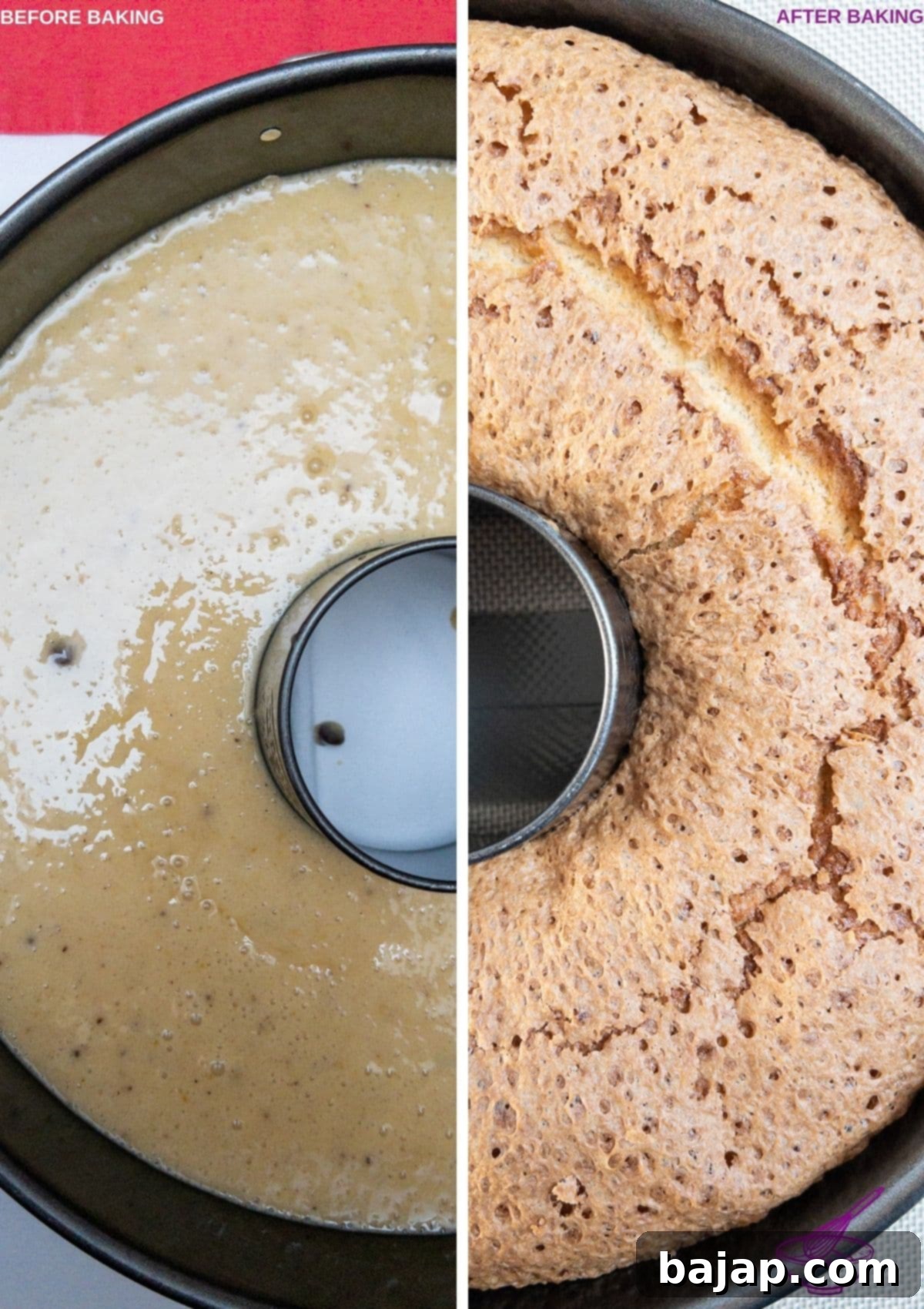
- Check for doneness: Towards the end of the baking time, it’s essential to test whether your cake is fully cooked through. Gently insert a wooden skewer or toothpick into the thickest part of the cake. If it comes out clean, without any wet batter clinging to it, your cake is ready! If not, continue baking for a few more minutes and test again.
- Cool and serve: Once baked, carefully take the cake out of the oven. Allow it to cool on a cooling rack in its pan for about 10-15 minutes. This allows the cake to set and firm up slightly before you attempt to remove it. Then, gently turn it out of the baking pan onto the cooling rack to cool completely. Once completely cool, dust generously with powdered sugar for a simple yet elegant finish.
This cake is so flavorful and has such a delightful texture that it truly doesn’t need any special extras for serving. The powdered sugar adds just enough sweetness and visual appeal. However, if you’re looking to elevate the experience, you can certainly add a dollop of freshly whipped cream to each serving plate, or a side of fresh berries to cut through the richness. A simple garnish can make it even more special. Now it is ready to be devoured! Enjoy every light, fluffy, and eggnog-infused bite!
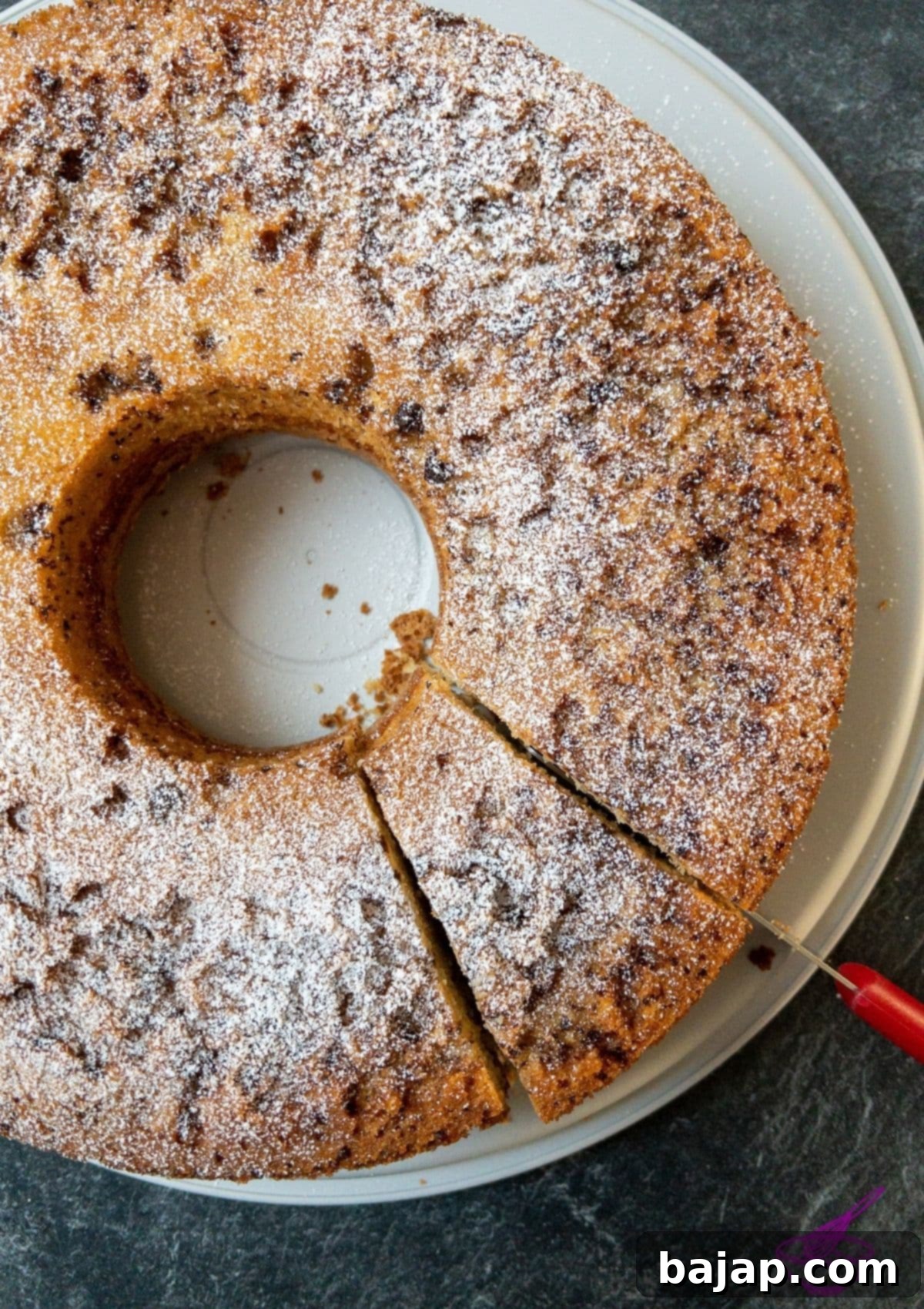
More Delicious Cake Recipes for You to Try
If you’ve enjoyed this delightful cake, you might be looking for more baking inspiration. Here are some other fantastic cake recipes from our collection that we think you’ll love:
- Six egg white chocolate cake
- Flourless Chocolate Cake
- Old-fashioned whipping cream bundt cake
- Austrian strawberry sponge cake
- Ultimate double chocolate bundt cake
- Chocolate chip ricotta loaf cake
- Pumpkin pound cake (created by Call Me PMC)
📖 Creative Variations for Your Eggnog Cake
While the classic potato flour
🌡️ Storage Tips to Keep Your Cake Fresh
To ensure your delicious
💭 Top Tip for a Fluffy Batter
Achieving that perfectly light and airy batter is crucial for this cake’s signature texture. For creaming the eggs, sugar, and vanilla sugar, the whipping process works notably better with a high-quality hand mixer than with a food processor. A hand mixer allows for more control and effectively incorporates the necessary air, resulting in a lighter and fluffier base for your cake. While a food processor can combine ingredients, it might not provide the same level of aeration needed for the delicate crumb of this recipe.
Potato Starch Vs Potato Flour: Understanding the Difference in Baking
Often confused, potato starch and potato flour are distinct ingredients with different culinary applications, particularly in baking. Understanding their differences is key to achieving the desired texture in your recipes, especially in this fluffy eggnog cake.
What Is Potato Starch?
Potato is a remarkably versatile tuber and an excellent source of essential nutrients, including complex carbohydrates. Like most other carb-filled food items, potatoes contain a significant amount of starch. This starch is concentrated within the potato’s tuberous roots, where its cells are rich in leucoplasts – organelles responsible for starch synthesis and storage. Potato starch is extracted by crushing raw potatoes, releasing the starch granules, and then washing and drying them. The resulting product is a fine, white, powdery substance. It is essentially pure starch, devoid of protein and fat. When used in cooking and baking, potato starch acts as a powerful thickening agent, creating clear, glossy sauces and adding a delicate, tender crumb to baked goods without adding significant flavor. It’s often used in gluten-free baking to provide structure and moisture where gluten would typically do so.
What Is Potato Flour?
In contrast to potato starch, potato flour is made from whole potatoes – often cooked, dried, and then finely ground. This means it contains not just the starch, but also the protein, fiber, and other nutrients from the entire potato. As a result, potato flour has a denser texture, a more pronounced potato flavor, and a higher nutritional content compared to potato starch. It is much heavier and more absorbent. In baking, potato flour is used less as a primary flour and more as an additive to improve moisture retention, tenderness, and to add a unique flavor. Its high absorbency means that only small amounts are typically needed. In recipes like this eggnog cake, potato flour contributes to an exceptionally moist and tender crumb that is distinct from what traditional wheat flour alone can achieve, creating a wonderfully delicate texture. It’s also a good option for gluten-free baking when used in combination with other flours, offering a different profile than pure starch.
More Delicious Cake Recipes for You to Explore
- Six egg white chocolate cake
- Old-fashioned whipping cream bundt cake
- Austrian strawberry sponge cake
- Ultimate double chocolate bundt cake
- Chocolate chip ricotta loaf cake
- Chestnut Flour Cake
- Swiss Roll Cake (created by siftandsimmer.com)
If you embark on making this delightful potato flour eggnog cake, please let us know how much you loved it! We encourage you to rate it with a ★★★★★ star rating and share your thoughts by leaving a comment below. Your feedback is incredibly valuable to us and helps other bakers discover new favorites. This would be absolutely awesome! You can also sign up for our Newsletter to receive weekly delicious homemade recipes directly in your inbox, or follow us on Pinterest or Instagram and share your beautiful creations with our community. Just tag us @combinegoodflavors and use the hashtag #combinegoodflavors, so we don’t miss your culinary masterpieces!
📖 Recipe
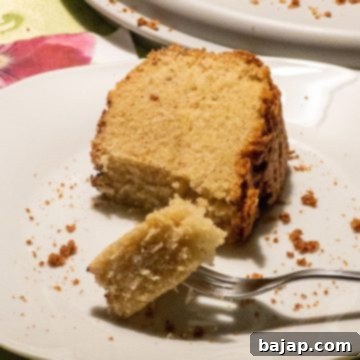
Potato Flour Cake with Eggnog
Nora
Prevent your screen from going dark
Save Recipe
Saved!
Pin Recipe
20 minutes
1 hour
30 minutes
1 hour
50 minutes
Dessert
European
28
Slices
164
kcal
Equipment
-
1 Spring bundt pan
-
Mixing bowls
-
Kitchen machine or Electric handmixer
-
Cooling Rack
-
Close meshed sieve
-
Tablespoon
-
Dough scraper
Ingredients
- 5 Eggs
- 2 ¼ cups Powdered Sugar
- 1 ¼ teaspoon Vanilla Sugar
- 1 ⅙ cups Oil Olive, Grapeseed, Canola
- 1 ⅙ cups Eggnog
- 1 cup all-purpose flour
- 1 cup Potato flour
- 1 teaspoon Baking Powder
Instructions
-
Preheat your oven to 160 °C // 320 °F top/bottom heat.
-
Prepare a mixing bowl in advance and mix 1 cup all-purpose flour, 1 cup Potato flour, and 1 teaspoon Baking Powder together. You’ll need it later.1 cup all-purpose flour,
1 cup Potato flour,
1 teaspoon Baking Powder -
Sift 2 ¼ cups Powdered Sugar into a mixing bowl through a close-meshed sieve.2 ¼ cups Powdered Sugar
-
Add 1 ¼ teaspoon Vanilla Sugar and 5 Eggs and beat until creamy.1 ¼ teaspoon Vanilla Sugar,
5 Eggs -
Add 1 ⅙ cups Oil, 1 ⅙ cups Eggnog, and flour-baking-powder mixture.1 ⅙ cups Oil,
1 ⅙ cups Eggnog -
Grease the pan and pour in the dough.
-
Bake on the middle shelf for 80-90 minutes.
-
Let it cool on a cooling rack before you turn it out.
-
Dust with powdered sugar before serving.
Never miss a recipe!
Sign up and let me spoil you weekly with a delicious homemade recipe!
5 eggs recipe, advocaat recipe, Eggnog, eggnog cake, homemade egg liqueur, no butter cake, potato flour, potato flour cake, potato flour recipe
Like this recipe?
Mention @combinegoodflavors or tag #combinegoodflavors!
Nutrition values are estimates only, using online calculators. Please verify using your own data.
Serving:
1
Slice
|
Calories:
164
kcal
|
Carbohydrates:
18
g
|
Protein:
2
g
|
Fat:
10
g
|
Saturated Fat:
1
g
|
Polyunsaturated Fat:
3
g
|
Monounsaturated Fat:
6
g
|
Trans Fat:
0.04
g
|
Cholesterol:
35
mg
|
Sodium:
80
mg
|
Potassium:
76
mg
|
Fiber:
0.4
g
|
Sugar:
10
g
|
Vitamin A:
62
IU
|
Vitamin C:
0.3
mg
|
Calcium:
54
mg
|
Iron:
0.5
mg

🍰 You Might Also Like These Delicacies
If you’ve fallen in love with the comforting flavors and delicate texture of this eggnog cake, we’re confident you’ll enjoy exploring more of our delightful baking recipes. Here are some hand-picked suggestions that promise to bring more joy to your kitchen:
- Old-fashioned Whipping Cream Bundt Cake
- How to Make a Ricotta Vanilla Cream Cake
- The Ultimate Double Chocolate Bundt Cake
- Fresh Strawberry Sponge Cake
⛑️ Food Safety Guidelines for Home Baking
Ensuring food safety is paramount when cooking or baking at home. Following these guidelines will help prevent foodborne illnesses and keep your kitchen a safe environment:
- Cook to minimum temperature: Always ensure that dishes containing eggs or other perishable ingredients are cooked to a minimum internal temperature of 165 °F (74 °C). Use a food thermometer to verify.
- Prevent cross-contamination: Do not use the same utensils, cutting boards, or dishes on cooked food that previously touched raw ingredients, especially raw meat or eggs. Always clean thoroughly between uses.
- Wash hands frequently: Always wash your hands thoroughly with soap and warm water for at least 20 seconds, especially after touching raw ingredients, before and after handling food, and after using the restroom.
- Avoid extended room temperature exposure: Never leave perishable food (like cakes with egg-based frostings or fillings, or batters containing raw eggs) sitting out at room temperature for extended periods. Bacteria multiply rapidly between 40 °F (4 °C) and 140 °F (60 °C).
- Never leave cooking unattended: Always supervise food that is cooking on the stovetop or in the oven to prevent burning, overcooking, or potential fire hazards.
- Use appropriate oils: When frying or baking at high temperatures, use oils with a high smoking point to avoid producing harmful compounds.
- Ensure good ventilation: Always have good ventilation when using a gas stove or oven to prevent the buildup of carbon monoxide and other fumes.
For further comprehensive information and guidelines on safe food handling practices, we recommend checking the official resources from the U.S. Food and Drug Administration (FDA).
